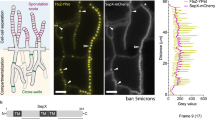Abstract
THE cellular slime mould, Dictyostelium discoideum, is an ideal organism with which to study the changes in cell behaviour resulting from the formation of cell–cell contacts (ref. 1 and for review, ref. 2). The role of adhesive interactions in the development of this organism is understood in outline and much is known about the nature and developmental kinetics of the macromolecules thought to be involved in establishing stable cell–cell contacts during aggregation3. There is now good evidence that the formation and maintenance of contact between amoebae is necessary for the synthesis of several developmentally regulated enzymes4 and several polypeptides characteristic of post-aggregation cells5. Clearly, it is important to understand the molecular mechanisms involved in cell–cell interactions, as they not only make multicellular aggregates structurally coherent, but also induce the synthesis of developmental gene products. In our attempts to identify the cell surface structures responsible for adhesion and developmental triggering, we have allowed starving amoebae to develop in the presence of proteolytic enzymes that might modify accessible cell surface proteins. We report here that in the presence of α-chymotrypsin amoebae are able to undergo normal aggregation and cell–cell adhesion but are unable to differentiate into stalks or spores.
This is a preview of subscription content, access via your institution
Access options
Subscribe to this journal
Receive 51 print issues and online access
$199.00 per year
only $3.90 per issue
Buy this article
- Purchase on Springer Link
- Instant access to full article PDF
Prices may be subject to local taxes which are calculated during checkout
Similar content being viewed by others
References
Newell, P. C. in Essays in Biochemistry Vol. 7 (eds Campbell, P. N. & Dickens, F.) 87–126 (Academic, New York, 1971).
Newell, P. C. Endeavour 1, 63–69 (1977).
Beug, H., Katz, F. & Gerisch, G. J. Cell Biol. 56, 647–658 (1973).
Newell, P. C., Sussman, M. & Longlands, M. J. molec. Biol. 58, 541–554 (1971).
Alton, T. H. & Lodish, H. F. Devl Biol. 60, 207–217 (1977).
Gerisch, G. Wilhelm Roux Arch. EntwMech. Org. 152, 632–654 (1960).
Jones, G. E. J. Membrane Biol. 16, 297–312 (1974).
Loomis, W. F. & Sussman, M. J. molec. Biol. 22, 401–404 (1966).
Town, C. D. & Gross, J. D. Devl Biol. 63, 412–420 (1978).
Kay, R. R., Garrod, D. & Tilley, R. Nature 271, 58–59 (1978).
Town, C. D., Kay, R. R. & Gross, J. D. Nature 262, 717–719 (1976).
Author information
Authors and Affiliations
Rights and permissions
About this article
Cite this article
SCHMIDT, J., STIRLING, J., JONES, G. et al. A chymotrypsin-sensitive step in the development of Dictyostelium discoideum. Nature 274, 400–401 (1978). https://doi.org/10.1038/274400a0
Received:
Accepted:
Issue Date:
DOI: https://doi.org/10.1038/274400a0
This article is cited by
-
Melatonin: data consistent with a role in controlling ovarian function
Journal of Endocrinological Investigation (1987)
-
A mutation altering the function of a carbohydrate binding protein blocks cell–cell cohesion in developing Dictyostelium discoideum
Nature (1979)
Comments
By submitting a comment you agree to abide by our Terms and Community Guidelines. If you find something abusive or that does not comply with our terms or guidelines please flag it as inappropriate.



